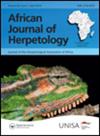疾病导致野生的Kihansi喷雾蟾蜍灭绝,Nectophrynoides asperginis
IF 0.9
4区 生物学
Q3 ZOOLOGY
引用次数: 0
摘要
坦桑尼亚Kihansi峡谷的喷雾蟾蜍(Nectophrynoides asperginis),尽管对其栖息地进行了种群监测和保护管理,但在野外已经灭绝。以前的调查表明,人类引起的栖息地改变、捕食者、杀虫剂和疾病可能是导致种群数量迅速下降和物种灭绝的原因。在这里,我们系统地研究了疾病在野生蟾蜍种群灭绝事件中的作用。在灭绝事件期间死亡的喷雾蟾蜍以及随后在Kihansi峡谷和邻近的Udagaji峡谷的其他两栖动物物种中发现了两栖壶菌,但在此之前收集的任何蟾蜍中都没有发现。随着数量的减少,剩余的喷雾蟾蜍数量在9个月的时间内逐渐消失。我们展示了人口统计学(罕见、低繁殖力、高海拔物种)和行为学(高密度聚集)属性是如何使喷雾蟾蜍易患壶菌病的,这是由于B. dendrobatidis感染的结果,以及如何通过改变喷雾湿地的环境条件加剧了流行病。结果表明,壶菌病是野生曲霉菌灭绝的近因。这是非洲已知的第一例因疾病导致两栖动物灭绝的案例。在美国和坦桑尼亚,为了确保该物种的生存,已经引入了圈养繁殖计划,并正在进行重新引入计划。然而,我们提醒,壶菌病仍然是一种存在的威胁,在实现既定的遣返蟾蜍种群的预期保护结果之前,需要一个全面的缓解战略。本文章由计算机程序翻译,如有差异,请以英文原文为准。
Disease driven extinction in the wild of the Kihansi spray toad, Nectophrynoides asperginis
ABSTRACT The Kihansi spray toad, Nectophrynoides asperginis, became extinct in the wild despite population monitoring and conservation management of its habitat in the Kihansi gorge, Tanzania. Previous investigations have indicated human induced habitat modification, predators, pesticides and disease as possible causes of a rapid population decline and the species extirpation. Here, we systematically investigate the role of disease in the extinction event of the wild toad population. The amphibian chytrid fungus, Batrachochytrium dendrobatidis, was detected in spray toads that died during the extinction event and subsequently in other amphibian species in Kihansi Gorge and the adjacent Udagaji Gorge, but not in any toads collected prior to this. Following the population decline, the remaining spray toad population gradually disappeared over a nine-month period. We demonstrate how demographic (rare, low fecundity, high elevation species) and behavioural (congregate in high densities) attributes predisposed the spray toads to chytridiomycosis, as a result of B. dendrobatidis infections, and how epidemic disease could have been exacerbated by altered environmental conditions in the spray wetlands. Our results show that chytridiomycosis was the proximate cause of extinction in the wild of N. asperginis. This represents the first known case of extinction by disease of an amphibian species in Africa. Captive breeding programs, in both the US and Tanzania, have been introduced in order to ensure the survival of the species and a reintroduction program is underway. However, we caution that chytridiomycosis remains an existing threat, which requires a comprehensive mitigation strategy before the desired conservation outcome of an established population of repatriated toads can be achieved.
求助全文
通过发布文献求助,成功后即可免费获取论文全文。
去求助
来源期刊

African Journal of Herpetology
ZOOLOGY-
CiteScore
3.00
自引率
6.70%
发文量
15
审稿时长
>12 weeks
期刊介绍:
African Journal of Herpetology (AJH) serves as an outlet for original research on the biology of African amphibians and reptiles. AJH is an interdisciplinary journal that publishes original articles and reviews from diverse fields and disciplines, such as conservation, phylogenetics, evolution, systematics, performance, physiology, ecology, behavioural ecology, ethology, and morphology.
The Journal publishes two issues a year. There are no page charges .
 求助内容:
求助内容: 应助结果提醒方式:
应助结果提醒方式:


